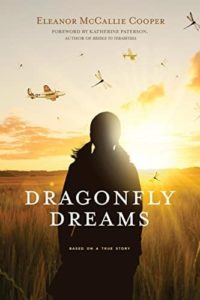 Dragonfly Dreams
Dragonfly Dreams
By Eleanor McCallie Cooper
Virginia Beach, VA: Koehler Books, 2021
184 pages, ISBN: 978-1646634231, Hardcover
2021 Royal Dragonfly Book Award Historical Fiction Honorable Mention and Winner of the Pinnacle Book Achievement Award for Young Adult Historical Fiction of the National Association of Book Entrepreneurs
Reviewed by Anne Prescott
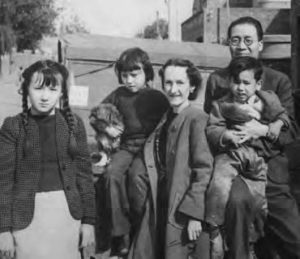
Dragonfly Dreams chronicles the life of the Liu family in Tianjin, China, in the early 1940s, a time and place in history often overlooked by Americans. Appropriate for middle school grades and above, the captivating story is a vehicle for learning about China, and it can also be used to teach about the challenges and joys experienced by young people during times of conflict.
This story is based on the life of an actual family living in a foreign settlement in Tianjin prior to and during the Japanese occupation in 1941–1945, and is told through the eyes of Nini, who is ten years old when the story begins. Author Eleanor Mc-Callie Cooper (Nini’s cousin in real life) skillfully weaves together Chinese history and culture with the daily life experiences of Nini and her family: Da (Liu Fu Chi, “F. C.”), the US-educated Chinese father; Ma (Grace Mc-Callie Divine Liu), the American mother from Chattanooga, Tennessee; Julia (Ju-lan, nicknamed Nini), the US-born oldest child; Ellen (Mei-mei), the middle child; and William (Weilin), the baby of the family.
The author primarily explores the impact of war on the Euro-American community in Tianjin (and by extension in China), the Liu family, and Nini (and by extension children like her). The author has carefully crafted fictional characters of diverse backgrounds and nationalities to present a well-rounded picture of the various communities in Tianjin during those years. Through Nini’s friend Chiyoko, whose father is a Japanese doctor and whose mother is Chinese, we get a glimpse of the struggles of a family with ties to both the colonizers and the colonized. The hardships faced by the Euro-American community are expressed through the Irish piano tuner, Nini’s British classmates, the family doctor, and the American director of the YMCA married to a Chinese woman. Auntie Boxin, a widowed Korean woman, who is not an enemy of the Japanese, is present throughout the story and plays a critical role in the family’s survival. Sun and Amah, the family’s household employees, provide assistance to the family at key moments in the story. Finally, Mr. Yasemoto, the boss for the Japanese organization that takes over Da’s company, launches the family into their initial upheaval.
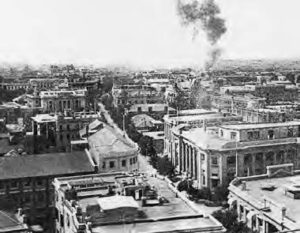
over the British Concession until after the bombing of the US Naval fleet in Pearl Harbor in 1941.
Americans and Europeans were encouraged to return home after December 1941, but like Ma, some decided to remain in China. For many, it was the only home they had ever known. Among the challenges the Euro-American community faced were compulsory registration, wearing armbands to visibly signify their status, and removal to internment camps. Through their stories, we learn the nuanced impact of the war and the Japanese occupation on the Euro-Americans who remained in Tianjin.
The camps, mentioned briefly in the story, are worthy of further exploration, perhaps in conjunction with the experiences of other wartime internees in similar camps in the twentieth century. To learn more about the camps in China, readers may want to consult the book Ruth’s Record: The Diary of an American in Japanese-Occupied Shanghai 1941–1945 by Ruth Hill Barr, which offers a view of life in a Japanese internment camp in China. An interview with Barr’s daughter Betty about the family’s experiences provides a glimpse into the material presented in the book
(https://tinyurl.com/2nf894jy).
For the Liu family, Ma’s status as an enemy is the origin of some of the obstacles they face. Because of his marriage to an American, as well as his unwillingness to do the bidding of the Japanese occupiers, Da loses his job, and with it the family’s income and employer-provided comfortable housing. By the end of the story, the Liu family is effectively in hiding in a rural area near the city, where Ma is able to avoid the Japanese authorities. The family, like many in China, also faced housing crises, hunger, and illness. Nini and her siblings learn to scavenge for food, and the family explores traditional remedies for illnesses, although obtaining the ingredients for those proves to be only slightly easier than obtaining Western medical treatment. When Nini undertakes a treacherous visit to the city to obtain medicine for Mei-mei, who has typhoid, we learn a little about what life has been like for Chiyoko’s Japanese father, Dr. Mori. His position as a medical professional brings with it the benefits of access to food and medicine, but their status as a mixed family has led to its own dilemmas of where they belong.
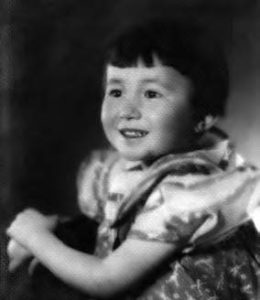
Many of the obstacles Nini confronts will resonate with children facing adversity and disappointment, whether due to war or other situations. From the beginning, Nini is faced with the challenge of identity: is she Chinese or American? Many classmates at her international school see her as Chinese and thus inferior. One schoolmate, who is also half-Chinese, considers himself to be superior to Nini because he has an American last name. Her friend Chiyoko, who is also half-Chinese, is her ally and best friend. For Nini, her status as American enemy manifests itself in the
necessity for Da to destroy all letters from her beloved grandmother in Tennessee. Many children who have experienced pandemic isolation will be able to relate to the burden Nini feels being separated from Chiyoko, but she finds comfort in the dragonfly necklace Chiyoko gave her as a present on what turned out to be their last day of school.
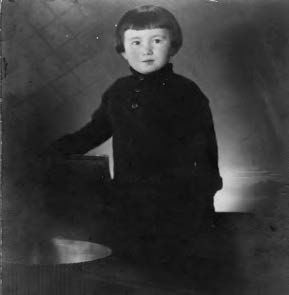
Skillfully woven into the narrative are historical events. Pearl Harbor is the catalyst that sends the family into their uncertain future, and Da explains the Japanese occupation to Nini in the historical context of Pearl Harbor, the Opium Wars, and the Boxer Rebellion. Dragonfly Dreams includes a historical timeline specific to this story, but educators and students alike may find it useful to refer to Asia for Educators’ timeline of Chinese history from 1900 to 1950, including the years of Japanese rule in Tianjin (https://tinyurl.com/2jbdn85v).
Both Chinese and Euro-American cultures are incorporated into the narrative. A favorite family object, a Monkey King figurine, surfaces in several key family struggles. Lunar New Year and Moon Festival celebrations are observed, and Nini reminisces about the prewar festivities as she and her family try to find meaningful ways to modify those celebrations, given the food shortages they face. References to Ma’s piano, St. Patrick, the story of Hansel and Gretel, opera, and Charles Dickens’s Oliver Twist are expressions of the family’s Western side. All these lend themselves to
discussion about their roles in creating an identity for family members.
Dragonfly Dreams belongs on the shelves of all middle and high school libraries. Through Nini, readers can explore Chinese history and culture in the years 1941–1945, expanding their knowledge of the Pacific War and its impact on children. By extension, perhaps readers will begin to relate Nini’s experiences to their own lives, the lives of their friends, and those of children in other war situations.
Additional Resources to Complement Dragonfly Dreams
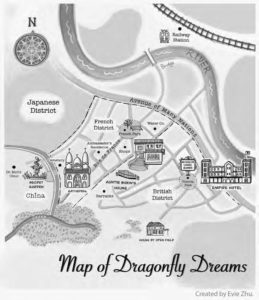
Readers wishing to learn more about the historical and cultural topics included in Dragonfly Dreams should begin with McCallie Cooper’s nonfiction work Grace in China, soon to be republished, about the life of Grace Liu, Nini’s mother. This eye-opening account of Grace’s commitment to her family provides information on Grace’s life before and after the years in Dragonfly Dreams and is appropriate for high school students, as well as adults. A review of Grace in China appeared in Education About Asia in winter 2000.
Dragonfly Dreams contains a map of the areas described in the story, but geography teachers may want to supplement that with a historical map of Tianjin. https://tinyurl.com/2vytauw7
The Monkey King and the story Journey to the West are always popular with children and could be used effectively to draw students into the story. Here are two resources to begin learning more. Gray and Wang, “Journey to the West: A Platform for Learning about China Past and Present,” Education About Asia 24, no. 1 (2019): https://tinyurl. com/mpfmeyf6; and Ostendorf,” Novel Adventures: Using the Journey to the West to Teach Tang China History and Culture,” Education About Asia 25, no. 2 (2020): https://tinyurl.com/y69ejutx.
Although religion is not included in Dragonfly Dreams, teachers may be interested in expanding on Monkey to teach about religion. A good starting point is Johnson and Bradeen, “Using ‘Monkey’” to Teach Religions of China,” Education About Asia 10, no. 2 (2005): https://tinyurl.com/47dme4mz.
Dragonfly Dreams: Author’s Note
by Eleanor McCallie Cooper

Dragonfly Dreams is based on a true story. When I was just out of college and on my way to Japan to teach English, my Aunt Mary in California told me that her cousin Grace had married “a Chinaman” and moved to China with him years before. China was closed at the time I learned this, but I set my heart on finding her one day. But, as it turned out, she found me.
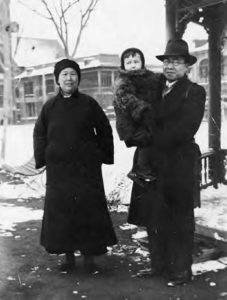
(nursemaid), Wang nai-nai, in Victoria Park, British Concession, Tianjin, China, 1935. Source: All photos are on the author’s website at https://tinyurl.com/22zx4jf9.
Grace McCallie Divine (1901–1979), went to New York City from Chattanooga, Tennessee, to study music in 1928. There she met and married Liu Fu Chi, “F. C.,” (1904–1955), a Chinese engineer who had just graduated from Cornell University and taken a job at New York’s public works. They had a daughter named Ju Lan, whose nickname was “Nini.” The Depression hit, and Mr. Liu returned to China to work for the water works in Tianjin. Grace and Ju Lan soon followed.
In 1937, the Japanese invaded mainland China, but European nations owned and governed territories in the coastal cities, called “concessions.” The Lius lived in the French Concession; therefore, at first they were protected from the turmoil of the Japanese invasion. They had two more children, a daughter in 1937 and a son in 1941.
After the attack on Pearl Harbor, however, Japanese troops took control of the foreign concessions in China. The Americans and Europeans remaining there were forced to register as enemy aliens and, eventually, moved into internment camps.
Grace narrowly escaped internment and lived in hiding with the family until the war ended in August 1945. Her family back home did not know if Grace was alive until a Marine from Chattanooga, private Giles Brooks, found her, weighing barely eighty-six pounds, and sent word home that she had survived. Grace Liu and her family continued to live in China after the war. Her husband died of lung cancer in 1955. Grace Liu taught English at Nankai University where she was arrested during the Cultural Revolution and accused of being a spy and counter revolutionary. After President Nixon and Chairman Mao established diplomatic relations between the two countries, she wrote to her family in Tennessee and returned in 1974 with her son, William. She had lived in China for forty years.
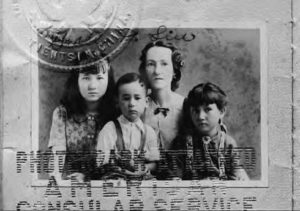
William.
I had a chance to live with Grace the last year of her life and become very close to her. Her son William worked at UC Berkeley. Grace began to write her memories. With a diagnosis of cancer, her two daughters came from China to help with her care. This is the way I came to know my remarkable Chinese cousins.
After Grace died in Berkeley in 1979, her two daughters returned to China where they both had families. William became the director of English language programs for Chinese interpreters at Simon Fraser University in Vancouver, Canada.
The full story is told in two books: Grace in China: An American Woman Beyond the Great Wall, 1934–1974 (Black Belt Press, 2000) and in Grace: An American Woman in China, 1934–74 (Soho Press, 2003) by Eleanor McCallie Cooper and William Liu.
In Dragonfly Dreams, the family (Chinese father, American mother, and three children) and the historical dates and facts form the structure of the story, like an envelope; but the content of the story, the letter that goes inside the envelope, is fictional.
—Eleanor McCallie Cooper
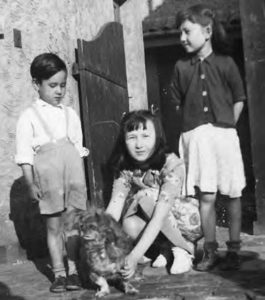
Ju-lan is holding their dog, Budgie. The photo was taken by US Marine Jimmy Lail
from Chattanooga, 1946.
STUDY GUIDE: Questions for discussion
1. Why does Nini feel that the foreign girls at the international school treat her as if she was the foreigner in China?
2. It’s easy to identify with Ma’s confusion about how a small island nation could occupy a large country like China. Why do you think Japan waited until the bombing of Pearl Harbor
to take over the foreign-controlled areas in China?
3. What do oranges and airplanes represent in Nini’s imagination? What do snakes and frogs represent? Along this same line, why did Sun give a puppy to Mei-mei?
4. When Nini was quarantined with the whopping cough, she felt like all of China was quarantined from the rest of the world. Can you describe your feelings during the COVID-19 pandemic?
5. Chiyoko is a fictional character but what do you think happened to her after the war ended?
6. In this story, there are many examples of the need for one person to forgive another person. Name those you can think of. Why is the theme of forgiveness important to war?
7. The principal at Nini’s school blamed America for China’s troubles and compared Americans to devils who wanted to “chop off children’s heads.” Nini knew this was not true, and yet she was still treated badly. Later she learned the word propaganda. How can you distinguish between what is true and what is propaganda in times of war or other crises?
Please review article PDF for Dragonfly Dreams Historical Timeline and post-war letter from Ju-lan to her American Cousin.

